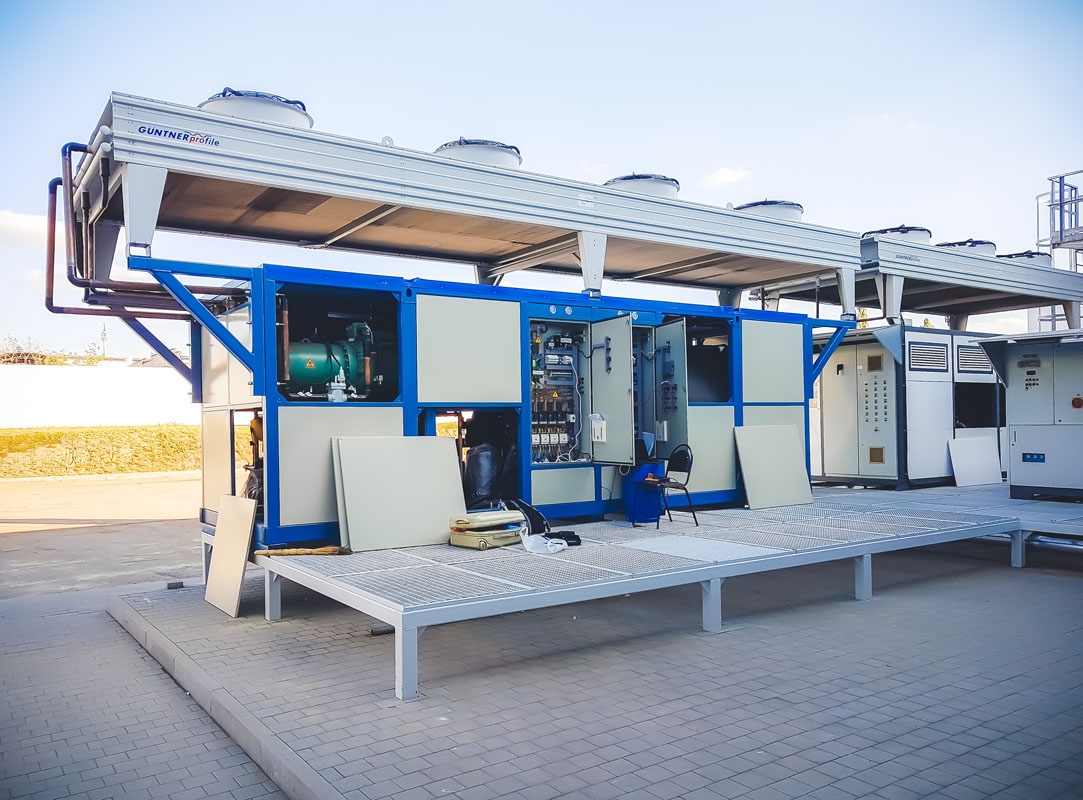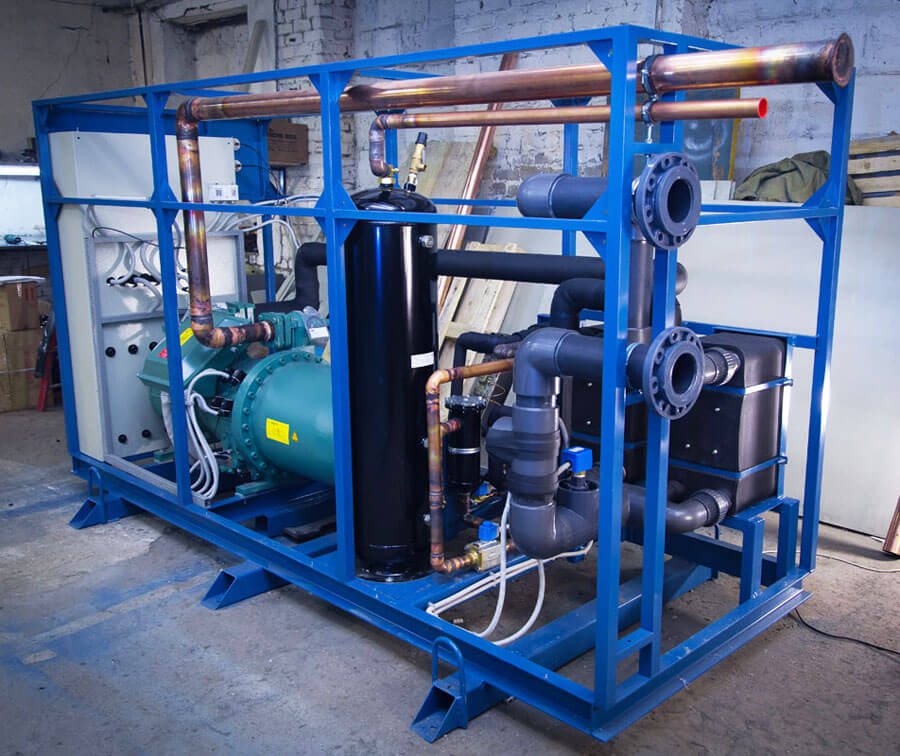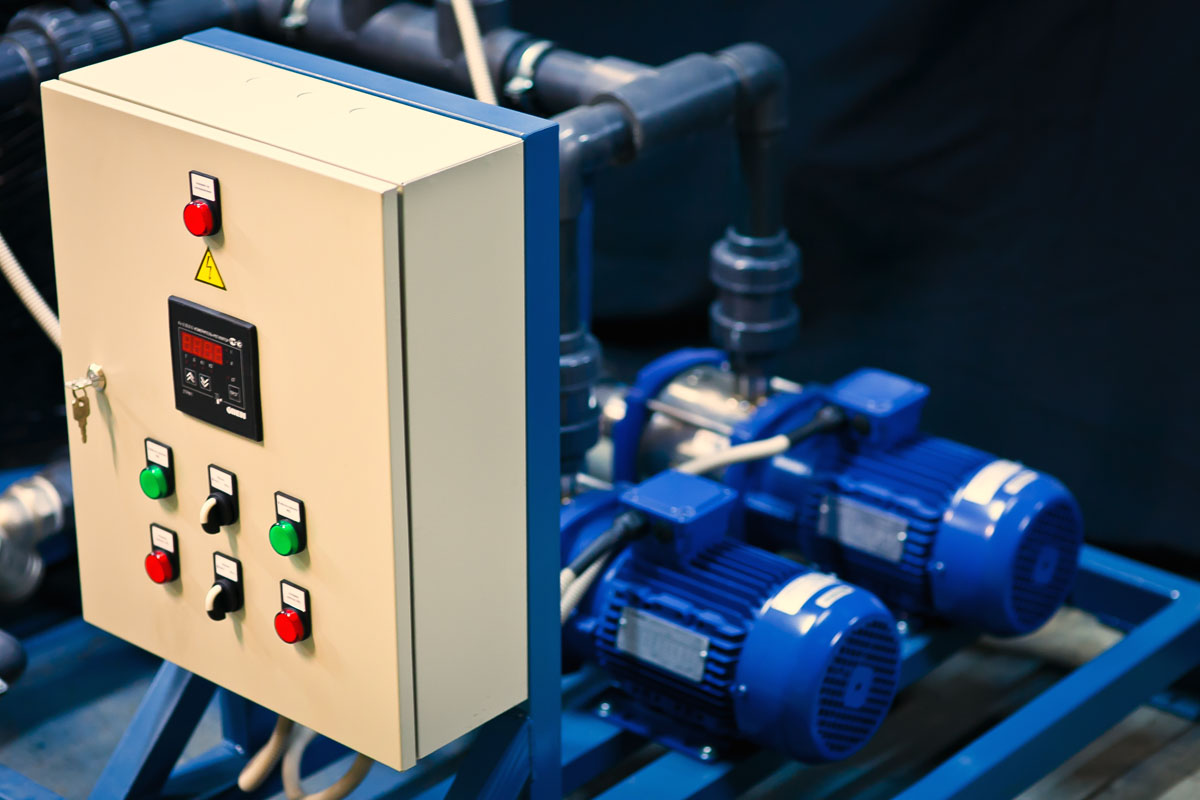What's a chiller. Basic types, device. FAQ.
A chiller is a refrigeration machine for cooling liquids using a steam-compression or absorption refrigeration cycle. After cooling in the chiller, the liquid can be fed into heat exchangers to cool the air (fancoils), to remove heat from the equipment or into the reactor cooling jacket. During the process of cooling the liquid chiller creates excess heat, which should be released into the environment. Working with fancoils in air conditioning systems are special cases of chillers. Chillers themselves are widely used in industry: injection molding, lasers, machine tools, nuclear power plants, semiconductors and much more.
There are several types of chillers: steam compression cycle and absorption. Absorption chillers are produced by well-known manufacturers of climatic equipment: ShuangLiang Eco Energy (the largest manufacturer), Carrier, Trane, Thermax, York, Century, Broad.

Chiller-fancoil system - an air conditioning system in which the coolant between the chiller (refrigeration unit) and fancoils (heat exchangers, air cooling units) is a cooled liquid circulating under relatively low pressure - ordinary water (T - tropical climate +1 ... +40 C °) or aqueous solution of ethylene glycol (UHL - moderate and cold climate - 60 ... +40 C °). In addition to the chiller and fancoils, the system includes a pipe layout between them, hydromodule (pump station).
Chillers contain a chemical compound called freon - colorless gases or liquids without odor. CFCs are very inert chemically, so they do not burn in the air, are not explosive even when in contact with an open flame. However, when CFCs are heated above 250°C, very toxic products are formed, such as phosgene COCl2, which was used as a warfare agent during the First World War. The name "CFC" of DuPont (USA) has been used in literature for many years as a general technical term for refrigerants. In the USSR and RF the term "refrigerants" has taken root. There are many types of the refrigerant and applications depending on required temperatures (R407C, R410a, R404a, R134a), but all of them work according to the main principle of compression and phase transformation of the refrigerant from liquid to gas and back to liquid. This process of heating and refrigeration of the refrigerant and its replacement from gas to liquid and back is a refrigeration cycle. CFCs are also used in fire extinguishing at hazardous facilities (e.g. power plants, ships, etc.).
Chiller with remote capacitor
Chiller with a remote condenser is a refrigeration module, where the compressor, evaporator, valves are mounted on one frame in a single case. In this case, the chiller cooling module is placed inside the room, and the air-cooled condenser is taken outside or into another room.
Chiller with a remote condenser
The main advantages:
- possibility to use water all year round;
- high efficiency due to lack of glycol circuit and intermediate heat exchanger;
- quieter chiller operation due to the fact that there is no noise from running condenser fans;
- no heat is released into the room during operation;
- the chiller module is installed in a warm room, which is convenient for maintenance. When installing the chiller with a remote condenser must be aware that there are restrictions on the length of the refrigeration routes between the chiller and the condenser. The length of the line between the units should not exceed 15 meters. With additional equipment it is possible to carry out up to 50 meters.

Chillers with water cooled condenser
The condenser in chillers of this type is cooled by a liquid coolant: water or glycol solutions.
Due to low condensing temperature, water cooled chillers have a higher energy efficiency than air condensers. The heat is removed from the condenser by means of a liquid which is then cooled down in an additional heat exchanger - a dry cooler, a Dry cooler or an open cooling tower.
Main advantages:
- high efficiency due to low condensation temperature and the use of water as heat transfer medium;
- the chiller with a water condenser takes up little space compared to an air condenser;
- the dry cooling tower can be taken much further than the air condenser.
Monoblock chiller with air-cooled condenser
Monoblock chillers are used in central air conditioning systems with air inlets and in "chiller-fancoil" systems. Monoblocks have two modifications:
- with axial fans;
- with centrifugal fans.
- monoblock chiller
Chillers with axial fans are chillers mounted on a frame in a single unit and installed in the room or on the roof of the building or on the street on a prepared site. Heat is discharged into the environment.
Hydromodule - pumping station
Hydromodule or pump station is the equipment that is used together with the chiller and serves for circulation of liquid in the system by pipeline, between the chiller and cooling equipment or fancoils. hydromodule consists of the following main components:
- feed pump, circulation pump, backup pump;
- a thermally insulated storage tank;
- expansion vessel (serves for compensation of temperature expansion and compression of the coolant);
- control panel and automation system;
- filter;
- shut-off valve;

Since the heat load varies depending on the time of day or season, there are periods of time when the chiller cooling capacity is significantly higher than the real need. In this case, the chiller starts working with short pulses, switching on and off. Frequent starts of the compressor lead to its rapid wear and a noticeable reduction in service life. To avoid this, a storage tank is sometimes installed in the system, the volume of which is calculated on the basis of possible thermal loads and the amount of coolant in the system. In this case, the total volume and heat capacity of the coolant increases, so that the intervals between switching on and off the compressor increases.
How the chiller works
Theoretical basis on which the principle of chillers is built is the second beginning of thermodynamics. Cooling gas in chillers performs the so-called reverse cycle of Renkin - a kind of reverse cycle Carno. In this case, the main heat transfer is not based on compression or expansion of the Carno cycle, but on phase transitions - evaporation and condensation. Refrigeration and air conditioning equipment of compression type with low power action has a similar device:
- a compressor that creates the necessary pressure differential;
- evaporator that takes heat from the liquid;
- a condenser that gives heat to the environment;
- Throttling device that maintains the pressure differential due to throttling of the refrigerant;
- Freon - a substance that transfers heat from the evaporator to the condenser.
Compressor sucks the refrigerant from the evaporator as vapor, compresses it (at the same time the refrigerant temperature rises) and pushes it into the condenser. Special refrigeration oils are used for lubrication of the compressor. It should be noted that the oil and refrigerants R-22, R-12 are well dissolved in each other. Later refrigerants (R-407° C, R-410A, etc.) do not dissolve oils and polyester oils are used for compressor lubrication. Polyester oils are extremely hygroscopic, enter into chemical reaction with water and decompose.
In the condenser, the refrigerant heated as a result of compression cools down, giving heat to the external environment, and at the same time it condenses, i.e. turns into a liquid that enters the throttling device.
Liquid refrigerant enters the evaporator through a throttling device (capillary or thermostatically controlled expansion valve) under pressure, where due to sharp decrease of pressure evaporation of liquid takes place. At that the refrigerant takes heat from the inner walls of the evaporator, due to which cooling takes place.
Thus, in the condenser the refrigerant under the influence of a high pressure condenses and passes to a liquid condition, giving out heat, and in the evaporator under the influence of low pressure boils and passes to gaseous, absorbing heat.
The thermoregulated expansion valve is necessary for creation of necessary difference of pressure between the condenser and the evaporator at which there is a cycle of heat transfer. It allows correctly (most fully) filling of the evaporator internal volume with boiling refrigerant. Transmission cross section of the TRV changes as the heat load on the evaporator decreases, as the temperature in the chamber decreases the amount of the circulating refrigerant decreases.
Chiller energy efficiency
The table below shows a comparison of cooling capacity and power consumption of chillers on the main types of compressors:
| Value | Piston | Spiral | Screw | | Q, kW | 99.9 | 102 | 103.2 | | N, kW | 33.66 | 30.08 | 32.4 | | COP/CPD | 2.97 | 3.4 | 3,18 | | Tock, A | 57.1 | 53.3 | 56.4 | Q - cold capacity.
N - power consumption.
The table shows that power consumption on scroll compressors is 10-15% less. Therefore, for air conditioning systems very often use scroll compressors in chillers.
The main most popular freons on which chillers are assembled is: R404a, R407° C, R410a, R134a. (R22 destroys the ozone layer, and production is limited by the Montreal Protocol).
| R134a | It is mainly used in hot climate when the ambient temperature reaches +50 ... +60C or if you need to maintain the water temperature in the chiller +25 ... 30 degrees. Compressor, filled with this freon, shows less cold performance than, for example, on R407° C. Ozone destruction potential ODP = 0. For operation with R134a refrigerant, only polyester refrigeration oils are recommended. 134a refrigerant is simply refilled after each leakage. | | R410a | Pressure in the contour at operating temperatures is considerably higher (so, at 43°C R22 has pressure of saturated steam of 15,8 atm, and R410A is about 26 atm.), that is why higher requirements are made to tightness, copper tubes of condenser and evaporator should be more durable, hence, larger mass of copper and higher price. (As metals and compounds age, the number of leaks in equipment increases). Another disadvantage of R-410A is its incompatibility with mineral oil. If R22 is dissolved in any mineral oil, then for freon R410a it is necessary to use special polyester oil, which is much more expensive, and besides, it requires more accurate filling (it very actively absorbs a moisture, losing its properties). On the other hand, R-410A has high specific cold-productivity (one and a half times higher than R-407° C and R22, two times higher than R-134A, which allows using a compressor with lower volume productivity. | | R407° C | R-407° C is a hydrofluorocarbon refrigerant not destroying ozone layer. It is designed to replace R-22 in many air conditioning systems. By its performance characteristics R-407° C is very close to R-22, which allows retrofitting of many units operating on R-22. R-407° C is a three component mixture with a temperature drift of about 6 OK. R-407° C refrigerant is not recommended in refrigeration systems with evaporation temperatures lower than −10°C. Most air-conditioning systems and heat pumps in which R-22 is currently used as refrigerant can be converted to R-407° C. | | R404a | This is mainly used in low-temperature chillers when it is necessary to obtain glycol temperature minus 15 and lower. The glide temperature is less than 0.5 K. Depending on the operating conditions it is provided the increase of cold-productivity by 4...5% and decrease of the discharge temperature in the compressor up to 8% in comparison with the similar characteristics of R502. | .
Chiller coolant temperatures
Chillers conditionally can still be divided by the temperature to which the coolant is cooled on:
- Average temperature with a liquid temperature of +5 ... +25C (air conditioning, cooling equipment, etc.);
- Low-temperature with liquid temperature of -20...0C (ice rinks, technological cooling, etc.);
- Ultra low-temperature with liquid temperature (brines, alcohols) -90...-30C (test stands);
- At a temperature of liquid above +30C is more appropriate to use cooling towers or air coolers ("dry cooling towers") instead of chillers.
The cost of chillers
The following major factors affect the cost of chillers:
- what temperature of the liquid to maintain;
- cooling capacity;
- ambient temperature;
- monoblock design, container or remote condenser;
- hydromodule availability
Major chiller malfunctions
- Freon leak. A leakage of CFC can occur as a result of an impermeable connection of the CFC circuit.
- Failure of compressor. In the compressor as a rule there is a combustion of winding of the stator or destruction of valves (piston group).
- Moisture in the refrigeration circuit. Moisture (water) in the refrigeration circuit can get as a result of leakage in the evaporator, resulting in the mixing of the two "freon-water" circuits.
Pros and cons of ABHM
Advantages of ABHM:
- Minimal power consumption. Electricity is required for the operation of pumps and automation.
- Minimal noise level.
- Environmentally friendly. The refrigerant is ordinary water.
- Dispose of thermal energy from discharged hot water, flue gases or production processes.
- Long service life (at least 20 years).
- Fully automatic.
- Fire and explosion protection.
- Absorption machines are not under the control of Rostechnadzor.
Shortcomings in absorption chillers
- Higher equipment price, approximately 2 times higher (at capacities below 500 kW) than the price of a conventional cooler. At higher capacities (2 MW and above) the price of ABHM is close to that of PCHM.
- The need for a cheap (free) heat source with a sufficiently high temperature.
- Relatively low energy efficiency - heat coefficient (ratio of supplied heat energy to the received cold), equal to 0.65-0.8 - for single-stage machines, and 1-1.52 - for two-stage machines.
- Significantly more weight than a normal chiller.
- ABHM chillers take up about 50% more space than equivalent steam compression chillers.
- Most freon chillers come from the factory filled with refrigerant. While the refrigerant and absorbent (including additives) must be installed in place in ABHM chillers.
- The need to use open chillers - cooling towers, which increases the water consumption of the system.
Calls and answers Question: What do chillers work on? Answer: Chillers are filled with the main refrigerants - R407C, R410a, R404a etc. Selection of freon depends on operating conditions and specific task for which the refrigeration facility is selected. On the consumer line, it is recommended to use water, because it has the best thermal and technical properties and the chiller heat exchanger will allow to operate at maximum efficiency. If there is a risk of water freezing, then use glycol solution. Question: What is better than a chiller or a driver? Answer: Coolant temperature when using a driver depends on the ambient temperature. If, for example, there will be +30 outside, the refrigerant will have a temperature of +35 ... +40C. Dreiculer is mainly used in cold seasons to save energy. The chiller can receive the set temperature at any time of year. Question: Which chiller is better - with water or air cooled condenser? But the condenser requires cold water to cool. The water-cooled chiller has a lower cost, but an additional dry cooling tower may be required if there is no water source - water supply or well. Question: What is the difference between a heat pump chiller with and without a heat pump? Answer: The heat pump chiller can be heated, i.e. not only cools the coolant, but also heats it. It must be taken into account that as the temperature drops, the heating deteriorates. Heating is most effective when the temperature drops below minus 5. Question: What distance can the air condenser be carried out? Answer: Typically, the condenser can be carried up to 15 meters. When installing an oil separation system, condenser outlet can be up to 50 meters, provided that the diameter of the copper lines between the chiller and the outlet condenser is correctly matched. Question: What is the minimum temperature at which the chiller works? Answer: When installing the system of winter start chiller operation is possible to the ambient temperature of minus 30 ... -40. And when installing fans of arctic design - up to minus 55.
|



